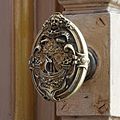Handle (device)
As handle are devices referred to, the main purpose of which is to facilitate grasping, holding, or the mechanical operation of an object or to enable.
For the purpose of mechanical operation, they fall under the control elements . Some weapons and tools of the handle is a booklet called.
To designate special handles, the intended use is usually put in front, for example in the word window handle.
Designs
According to the diverse areas of application, there are different designs.
The three universal design requirements for handles are:
- Sufficient stability to move the object in question or a mechanism that transmits the force in another way.
- Sufficiently large to enable the hand (or hands) to grip around.
- Extension behind the equator to ensure sufficient stability when gripping.
The general designs of handles can be categorized into three large groups:
Pull handles
Pull handles are operated with one or both hands. Mechanically, the force exerted by the operator should shorten the distance between the object and the shoulder. Horizontally arranged pull handles can be found on drawers and lock-free doors, for example.
Turning handles (knobs)
They are grasped with one hand and the force is exerted by turning around the longitudinal axis through the forearm. Rotary handles can be designed both spherical and lever-shaped. Another, less common version of the twist grip can be found on mechanically complex objects, such as the outer door of aircraft, which require a turning movement around the sagittal axis between the thumb and little finger.
Handles for extensive movements
Such grips are usually operated with both hands and are designed in such a way that powerful and extensive movements can be performed with them. This type of handle can be found on bicycle handlebars or axes, for example.
Ergonomics and appearance
The ergonomics of a handle should be designed according to the force to be used and the movement so that it can be operated easily. This means, for example, that if you have to use a greater force, the whole hand should be able to enclose it. It should also create a comfortable grip. Loose and wobbly handles create a feeling of insecurity.
The appearance of the handles is also often important as they are one of the most visible and distinctive components of an object.
An anti-slip coating is advantageous for handles, but this often has a negative effect on the ability to clean. Due to the improved cleaning options, stainless or galvanized metal or smooth plastic handles are preferred in public transport.
In furniture construction, in addition to the classic bow handle, button-shaped handles (usually called knobs), hanging handles and handle edges are also common.
Norms
- Bow handles to hold according to DIN 81421 part 1 and part 2
- DIN 1588 step-grip units for rail vehicles
- Operating handles of machine parts are dealt with by the standards committee NA 121-06-01 AA (see the list of standards there)
gallery
Door and window handles
Grab handles
Others
See also
- Doorknob (door handle)
- Window handle
- Handle bar
- Grab handle (vehicle)
- Parcel handle
Web links
Sources and individual references
- ↑ Scott Openshaw, Erin Taylor: Ergonomics and Design - A Reference Guide. (2006)
- ↑ a b c Helmut Strasser: Assessment of the Ergonomic Quality of Hand-Held Tools and Computer Input Devices (Ergonomics, Human Factors and Safety). Rittenhouse Book Distributors, 2007, ISBN 978-1-58603-788-8 .
- ↑ All valid standards from NA 121-06-01 AA. Online at DIN.de, accessed on December 21, 2016.














